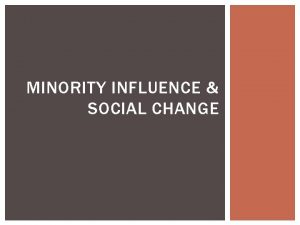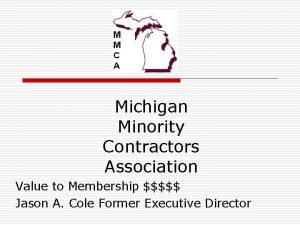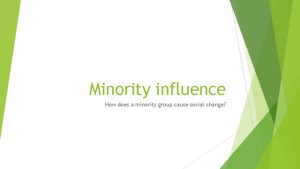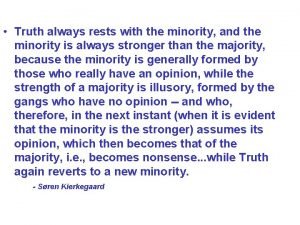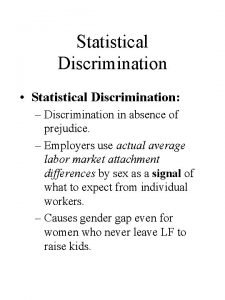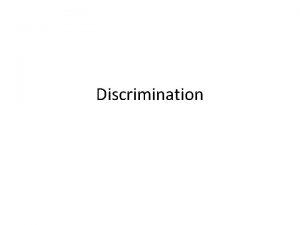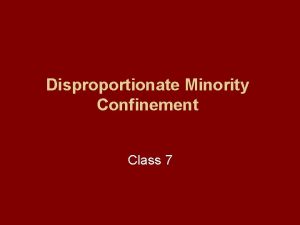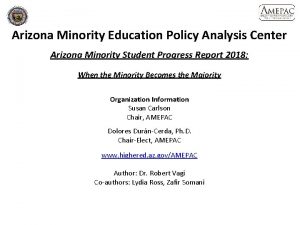MINORITY GROUPS IN THE US INSTITUTIONALIZED DISCRIMINATION Institutionalized



















- Slides: 19

MINORITY GROUPS IN THE US

INSTITUTIONALIZED DISCRIMINATION • Institutionalized discrimination- unfair practices that grow out of common behaviors and attitudes and are a part of the structure of a society • Public education serves as an example. Schools with large numbers of minorities are more likely to be found in large urban areas. Resources are not as readily available, need for better tech, and buildings in need of repair.

AFRICAN AMERICANS • Largest racial minority group in the US. 37 Million or 13% of population • There are many reasons for the lack of acceptance of African Americans into US society. • First, at a glance others can usually identify African Americans based off of physical features and skin tone. • Second, unfortunately it is historical…

AFRICAN AMERICANS • Africans were brought to the American colonies and were immediately at the lowest social class. Even when freed, people of color couldn’t rise up. • Once slavery was abolished (1865), prejudices and discrimination were wrote into the law. African Americans were segregated for almost another century. • Took until the 1960 s for equality to finally be available to African Americans • 350 years of being held down. So they’ve only been seen as equals constitutionally for the past 50 or so years.

INCOME LEVELS • On average, African American households earn only 62% of the income that White households earn on average. • When it comes to wealth there is even more of a difference. • The average African American household only holds about 20% of the average white household. • This can be traced to African Americans working more low level service jobs as opposed to professional, managerial, technical, or administrative jobs.

• Brought to US- taken from homeland, lowest class, not even seen as people • Freed from slavery- made laws to keep segregated and kept down • Overturn laws- institutionalized discrimination, unequal access to education, income, and employment • Income Levels- Below Whites (dominant group)

ADVANCES • Economic gains are on the rise, though they still need to rise more. • An increasing number of African Americans are graduating college. • Which are leading to better jobs and better income. • Business ownership is on the upswing. • And African Americans are increasing in their political presence. Not only the presidency, but congress, senate, and on the local levels as well.

LATINOS • Population is growing! • Estimates say that by 2050, 1 in 4 Americans will be Latino. • 3 biggest populations of Latinos are Mexicans, Puerto Ricans, and Cubans

EDUCATION AND INCOME LEVELS • Latinos fall behind white Americans in formal education. • Around 60% of Latinos finish high school as opposed to 90% White • On average, Latinos earn slightly more than African Americans, but still far less than Whites. And even that ranges. Cubans make 75% of what Whites do, while Puerto Ricans only make 50%. • 1 in 5 Latino families live below the poverty level compared to 1 in 10 for Whites.

LATINOS IN POLITICS • Latinos are becoming a force in American politics. • Now represented in the Congress and the Senate. One presidential candidate • Focus on education, immigration, and employment are their main focuses. • Interestingly enough, there is a divide between Latinos in America and keeping others from joining them here.

ASIAN AMERICANS • Make up 4% of population or 12 million • Largest groups are from China, the Philippines, Japan, India, and Korea • Chinese and Japanese immigrants could be seen as successes, but it hasn’t always been easy.

CHINESE AMERICANS • Attracted by the gold rush in California during the 1850 s. They worked low level jobs. • In the late 1800 s they were forced into urban ghettos known as Chinatowns. • Their situation began to improve after the 1940 s. • American born Chinese college grads began to enter professional jobs and became scholars and scientists that are publicly recognized for their contributions to the US. • Usually seen as hardworking and dedicated to their education.

JAPANESE AMERICANS • Immigrated in the late 1800 s and began to compete with white farmers. • Legislation was passed to take them out. (Couldn’t own farm land, couldn’t inherit land owned by family) • In 1941, Japan attacked Pearl Harbor. Japanese Americans were placed in camps because they were seen as a threat. They lost their homes and businesses they owned. • Yet German and Italian Americans were not put in camps…. hmmmmm…. • In the 1980 s, the US gov apologized and paid each internee $20, 000.

WHY HAVE SO MAN ASIAN AMERICANS BEEN SUCCESSFUL? • They use education as their upward mobility. • Asian Americans on average score higher on their SAT/ACT test than their peers. • Nearly half of Asian Americans complete at least a 4 year college degree • As opposed to 28% of whites, 19% of African Americans, and 7% of Latinos

QUESTIONS 1. How are general discrimination and institutionalized discrimination different? 2. Why do you think it has been so difficult for minorities to achieve equality in this country? 3. Why do you think some minorities do better than others when it comes to education?

• Two years ago my high school, Robert E. Lee High School, tried to change their name…. Why might they want to do that? • Many names were brought up to possibly change it to, many Latino figures were named as possibilities, but alumni did not want the change. • Why might alumni not want the change in name? • The school ended up being renamed… • L. E. E. High School- Legacy of Educational Excellence High School

OPEN RESPONSE • How is the meaning of race changing in the US today? • Do you have the same racial attitudes as your parents? • As you grandparents? • How do you think your kids will one day think of race?

STEREOTYPES IN MEDIA • List any stereotypes (in media and everyday life) of your race or ethnicity that you can think of. • Are these stereotypes mostly positive, negative, or neutral representations? • Do you agree with these representations? Do they seem accurate? • Would you say that some stereotypes shape the way that you view people from a different ethnicity or race?

SURVEY • Design a questionnaire that would measure people’s exposure to other races and cultures. • At least 4 questions. • Examples of questions could be: • How many people do you associate with daily who are not a member of your own race? • How many times in the past week have you had a conflict with someone of a different race? • Now answer these questions for yourself first. When you are done ask 5 classmates. • Try to get at least 5 responses between now and after Spring Break
 How are ethnic groups and religious groups related
How are ethnic groups and religious groups related Define delimit demarcate administrate
Define delimit demarcate administrate Middleman minority definition
Middleman minority definition 3 behaviours that enable a minority to influence a majority
3 behaviours that enable a minority to influence a majority Energy band diagram of pn junction
Energy band diagram of pn junction Doctoral initiative on minority attrition and completion
Doctoral initiative on minority attrition and completion Office of minority health resource center
Office of minority health resource center Minority pw
Minority pw Minority language definition
Minority language definition Minority ch 1
Minority ch 1 Michigan minority contractors association
Michigan minority contractors association Define minority group
Define minority group Financial literacy at minority serving institutions
Financial literacy at minority serving institutions Tsmsdc
Tsmsdc The term “minority majority” refers to the fact that
The term “minority majority” refers to the fact that Three purposes of control accounts
Three purposes of control accounts Minority serving institutions definition
Minority serving institutions definition Truth always rests with the minority
Truth always rests with the minority Electronic devices floyd 10th edition
Electronic devices floyd 10th edition Pnp minority carrier distribution
Pnp minority carrier distribution



